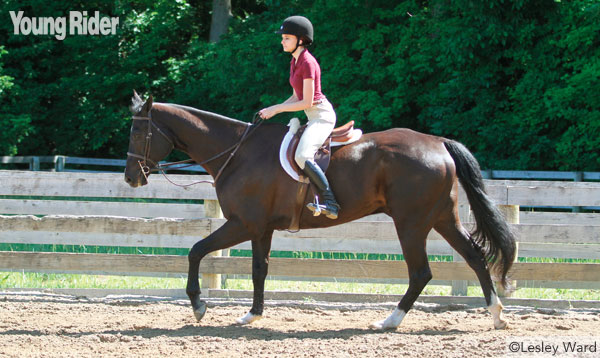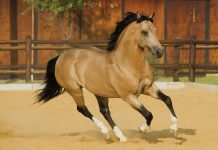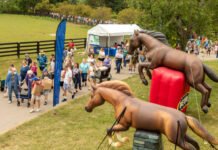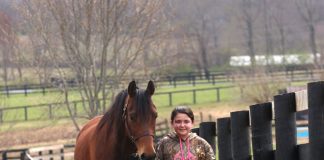
If you’re having cantering problems, take a look in the mirror. Say what? Most cantering conundrums are caused by the person in the saddle. Yes, you! If you bounce around on your horse’s back or don’t give him the correct cues you’ll probably have problems.
Cantering Cues
If you’ve ridden lots of different horses, you may have discovered that a cantering cue that works on one horse might not work on another. It all depends on who taught them how to canter as a greenie and what signals that person used on him. If you have problems getting a horse to canter right away, you might have to try some different cues to get him to respond.
The most common way to ask a horse to canter is to ask him for an active trot and when you reach a corner of the arena give the following cues:
- Sit up straight and tall
- Lift up the inside rein a tiny bit and move it slightly inward so your horse bends his body around your inside leg
- Press your inside leg on the girth
- Push your outside leg behind the girth and bump him with your outside calf.
In a perfect world, your horse will leap instantly into a balanced canter and he’ll be on the correct lead.
OK, so we know this doesn’t always happen. Let’s look at some things that can go wrong.
Trotting Race
Some horses just trot faster and faster to avoid cantering. When you finally get them to canter, they rush into it and feel unbalanced and out of control. How do you fix this?
Get his attention right away by sitting up tall and pull back on one rein and then release it when he slows down.
The second he trots nicely, ask for canter again in a firm, strong way.
If he doesn’t respond to your leg cue, tap him with a crop behind your outside leg. This might surprise him, but he must react the second your leg bumps him.
Wrong Lead
All horses pick up the wrong lead sometimes, but if your horse does it a lot try these two exercises:
- Trot your horse in a 20-meter circle in a corner of the arena and spiral in to the center. Ask for lots of bend around your inside leg. Then ask your horse to spiral out again by leg yielding. Put a little more weight in your outside stirrup and push him out with your inside leg. Spiral in and out a few times and as you are asking him to move to the outside with your inside leg, give him a big cue to canter with your outside calf.
- Set up a tiny cross-rail and trot over it several times as part of a 20-meter circle. To stay on the circle, you should jump it with your horse bending around your inside leg. If your horse is behaving, give him a big canter cue just as he’s taking off. If he gets the wrong lead, bring him back to the trot and circle round to the fence and try again.
Cross Cantering
Cross cantering is when your horse is on one lead in his front legs and the opposite lead in the back. It feels really strange and bumpy, so you’ll know he’s doing it immediately. Cross cantering happens when your horse is unbalanced. Greenies often cross canter. Just bring your horse back to the trot, get him balanced and moving forward energetically and ask for the canter again.
Bucking Bronco
Many horses think breaking into the canter is the perfect time to throw in a buck or two. Don’t let your horse get into this habit. Maintain a firm hold on both reins and lift up your inside hand slightly to keep your horse’s head up when you give him the cues to canter. If he starts putting down his head, sit up straight, push down your heels and quickly raise your outside hand and rein to pull up his head. Don’t let him pull you forward because once he’s got you perched up on his neck, it’s pretty easy for him to start bronking and it won’t be long before you’re flying through the air!
This article originally appeared in the March/April 2015 issue of Young Rider magazine. Click here to subscribe!





